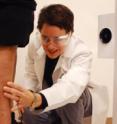New research reveals ultraviolet light therapy is as beneficial for darker skin as lighter skin
An analysis of more than 100 patients has confirmed for the first time that darker-skinned patients benefit as those with lighter skin when given light therapy for morphea and related diseases, UT Southwestern Medical Center researchers show. Phototherapy is the use of ultraviolet light to treat skin disorders, ranging from common problems such as acne and psoriasis to rarer conditions such as scleroderma and morphea, a hardening of the skin.
Some clinical observations have suggested that darker skin may not respond as well to light therapy, but the new data indicate that skin type does not significantly influence the effectiveness of UVA1 phototherapy, said Dr. Heidi Jacobe, assistant professor of dermatology at UT Southwestern and lead author of the study appearing in the June edition of the British Journal of Dermatology.
"This study is good news, indicating that UVA1 phototherapy should be considered as a therapeutic option for more darkly pigmented patients," noted Dr. Jacobe, who heads UT Southwestern's phototherapy clinic, one of a select few UVA1 phototherapy units in the Southwest.
Patients with diseases such as morphea respond better when treated earlier in the course of the disease, so it's important to know whether a particular treatment such as light therapy is useful.
Researchers reviewed 101 cases treated at UT Southwestern's phototherapy clinic over a three-year period ending in 2007, noting demographic and diagnostic data, skin type and clinical outcome, using standard improvement scales.
Researchers noted that the cumulative dose used did not vary significantly between skin types, and there was little or no correlation between skin type and clinical improvement scores.
The majority of patients treated at the center were diagnosed with either morphea or scleroderma. The maladies often cause discolorations of the thickened skin, usually red or purple in color, and therefore can be disfiguring. The discoloration may initially appear similar to a bruise that doesn't go away. The cause remains a mystery, and there is no known cure.
Dr. Jacobe has helped pioneer an experimental treatment that uses a highly specific range of ultraviolet light (UVA1) for some patients. Other treatments may include topical corticosteroids, antimalarials, systemic immunosuppressive medications and physical therapy.
In 2007, Dr. Jacobe launched the nation's first and only DNA repository for adults and children with morphea. People can contact the morphea registry office at 214-645-8971 or by e-mail at Christina.Carrigan@UTSouthwestern.edu. Information is also available at www.utsouthwestern.edu.
Researchers are collecting blood and skin samples to investigate genes and blood markers associated with morphea. Other information is used to identify and clarify its prevalence, its demographic distribution among race, gender and age, and recurrence rates. Currently, more women are diagnosed with the disease, but other factors aren't known. UT Southwestern dermatologists also hope to identify associated health problems that may be common for those with morphea, particularly rheumatic diseases such as lupus and rheumatoid arthritis.
Source: UT Southwestern Medical Center
Other sources
- Ultraviolet Light Therapy Is As Beneficial For Darker Skin As Lighter Skin, Study Showsfrom Science DailyThu, 10 Jul 2008, 21:21:12 UTC
- New research reveals ultraviolet light therapy is as beneficial for darker skin as lighter skinfrom PhysorgTue, 8 Jul 2008, 18:35:23 UTC
